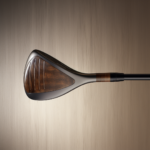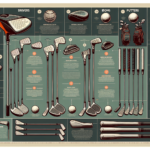
You’re ready to take your golf game to the next level, but are you confused about the different types of golf club cuts? Don’t worry, this comprehensive guide will break down everything you need to know about cut vs fade golf shots and help you master your technique. Let’s get started!
Understanding the Basics
In golf lingo, a “cut” refers to a shot that curves from left to right for right-handed players (and right to left for left-handed players), while a “fade” is a more controlled shot with a slight curve. Both shots are incredibly useful in certain situations on the course, but they require different approaches and techniques to execute successfully.
What is a Cut Shot?
A cut shot, also known as a slice, is a shot that starts left of the target (for right-handed players) and gradually curves to the right in the air. This type of shot is achieved by striking the ball with an open clubface relative to the swing path. A cut shot can help you navigate obstacles like trees or doglegs on the course.
What is a Fade Shot?
A fade shot is a more controlled type of shot that starts straight but has a slight curve to the right (for right-handed players) at the end of its flight. Unlike a cut shot, a fade is intentional and more predictable. This shot is great for pinpoint accuracy and playing in windy conditions where you want to keep the ball from drifting too far off course.
The Concept of Clubface Alignment
One of the key differences between a cut and a fade golf shot lies in how you align the clubface at impact. Understanding clubface alignment is crucial for achieving the desired ball flight and avoiding errant shots. Let’s take a closer look at how clubface alignment affects your shots.
Clubface Alignment for a Cut Shot
When hitting a cut shot, you want to open the clubface slightly in relation to your swing path. This means the clubface points to the right of your target at impact for right-handed players (left for left-handed players). By starting with an open clubface, you create the initial conditions for the ball to curve to the right, giving you that signature cut shot shape.
Clubface Alignment for a Fade Shot
In contrast, a fade shot requires more precise clubface alignment to achieve the desired ball flight. For a fade, you want the clubface to be slightly open but not as much as for a cut shot. This slight openness helps impart backspin on the ball and allows it to curve gently to the right without veering too far off course. Focus on squaring the clubface at impact to maintain control over your fade shots.
Body Position and Swing Path
Aside from clubface alignment, your body position and swing path play crucial roles in how you execute a cut vs fade golf shot. Proper alignment and swing mechanics can make all the difference in achieving the desired ball flight and landing your shots where you want them.
Body Position for a Cut Shot
When setting up for a cut shot, you want to aim slightly to the left of your target (for right-handed players). This alignment helps you swing along the desired path to promote the left-to-right ball flight characteristic of a cut shot. Keep your shoulders parallel to the target line and your weight slightly favoring your front foot to encourage the desired ball flight.
Body Position for a Fade Shot
For a fade shot, your body position should be square to the target line, allowing you to swing along a more neutral path. Focus on aligning your shoulders, hips, and feet parallel to the target to promote a straight flight with a gentle fade at the end. Maintaining a balanced weight distribution between your feet can help you control the clubface and execute the fade shot with precision.
Swing Path for a Cut Shot
The swing path for a cut shot is characterized by an out-to-in motion, where the clubhead approaches the ball from outside the target line. This path, combined with the open clubface, imparts side spin on the ball, causing it to curve to the right. Focus on swinging along the desired path while maintaining proper clubface alignment to achieve a consistent cut shot.
Swing Path for a Fade Shot
In contrast, a fade shot requires a more neutral swing path that approaches the ball from inside the target line. This inside-out motion, combined with a slightly open clubface, creates a controlled fade with backspin. Pay attention to your swing path and ensure that you’re not swinging too sharply from outside to inside, as this can lead to unwanted slices instead of fades.
Equipment Considerations
While technique plays a significant role in executing cut vs fade golf shots, your equipment can also affect the outcome of your shots. The type of club you use, its design features, and even the ball you play with can influence how effectively you can execute these shots. Let’s explore some equipment considerations for mastering cut and fade shots.
Club Selection for Cut and Fade Shots
Certain clubs are better suited for cut shots, while others excel at producing fade shots. For cut shots, consider using a club with higher loft, like a driver or fairway wood, to help launch the ball in the desired trajectory. These clubs can also help add backspin to counteract the natural side spin of a cut shot. For fade shots, irons with a lower loft are ideal, as they can produce a more controlled ball flight with a gentle curve.
Club Design Features
The design features of your clubs can also influence the type of shot you’re able to produce. Clubs with perimeter weighting or adjustable hosels can help you fine-tune your clubface alignment and promote a more consistent ball flight. Pay attention to the design elements of your clubs and experiment with different models to see which ones work best for your desired shot shape.
Ball Selection for Cut vs Fade Shots
Believe it or not, the type of ball you play with can impact the outcome of your cut and fade shots. Some golf balls are designed to produce more spin, while others are engineered for distance and control. Choose a ball that complements your shot-making style and helps you achieve the desired ball flight. Experiment with different ball types on the driving range to see how they affect your shots.
Practicing Cut and Fade Shots
Now that you have a solid understanding of the differences between cut and fade shots, it’s time to put your knowledge into practice. Practicing these shots on the range can help you fine-tune your technique, build confidence, and ultimately improve your performance on the course. Here are some tips for practicing cut and fade shots effectively.
Start with the Basics
Before attempting cut and fade shots, make sure you have a solid grasp of the fundamentals of your swing. Focus on maintaining proper grip, stance, and alignment to set yourself up for success. Work with a golf instructor or coach to refine your technique and address any swing flaws that may impede your progress.
Experiment with Different Clubs
Try hitting cut and fade shots with different clubs in your bag to see which ones work best for your game. Experiment with drivers, irons, and wedges to discover which clubs allow you to produce the desired ball flight. Pay attention to how the loft, design features, and shaft flex of each club affect your shots and adjust your approach accordingly.
Utilize Training Aids
Consider using training aids like alignment sticks, impact bags, or swing trainers to improve your ball-striking and shot-shaping skills. These tools can provide instant feedback on your swing mechanics and help you make adjustments to achieve the desired cut or fade shot. Work with a qualified instructor to incorporate training aids into your practice routine effectively.
Practice with a Purpose
When practicing cut and fade shots, focus on specific targets on the range to simulate real course conditions. Aim for different distances and trajectories to challenge yourself and build shot-making skills. Visualize the ball flight you want to achieve before each shot and commit to executing the proper technique to achieve your desired outcome.
Troubleshooting Common Issues
Even the most seasoned golfers can struggle with cut and fade shots from time to time. If you’re experiencing consistency issues or getting unwanted results, don’t panic. By identifying common problems and implementing solutions, you can overcome obstacles and improve your shot-making ability. Let’s address some common issues and how to troubleshoot them.
Overcooking the Cut Shot
If you find that your cut shots are curving too much to the right or slicing uncontrollably, you may be overcooking the shot. To remedy this, focus on maintaining a neutral grip and squaring the clubface at impact. Adjust your setup to promote a more inside-out swing path and avoid swinging too aggressively from outside to inside. Practice hitting shots with a softer touch to reduce excessive side spin and achieve a more controlled cut shot.
Missing the Fade Shot Target
If your fade shots are consistently missing the intended target or falling short, you may need to address your alignment and swing path. Check your body position and ensure that your shoulders, hips, and feet are square to the target line. Focus on maintaining a smooth swing tempo and accelerating through impact to generate the backspin necessary for a proper fade. Experiment with different clubs and ball positions to find the setup that allows you to hit your target consistently.
Inconsistent Ball Flight
Inconsistency in ball flight can be frustrating for golfers trying to master cut and fade shots. To improve your consistency, focus on developing a repeatable swing sequence and addressing any technical flaws that may be affecting your shots. Work with a coach or instructor to identify the root cause of your inconsistency and implement drills or exercises to help you refine your technique. Practice with a purpose and track your progress to ensure that you’re making strides toward more consistent shot-making.
Conclusion
Congratulations, you’ve now completed the ultimate guide to different golf club cuts and are well on your way to mastering cut vs fade shots. By understanding the nuances of these shots, refining your technique, and incorporating equipment considerations into your game, you can elevate your shot-making skills and tackle any course challenge with confidence. Remember to practice with purpose, seek feedback from experts, and remain patient as you work towards perfecting your cut and fade shots. Happy golfing!





